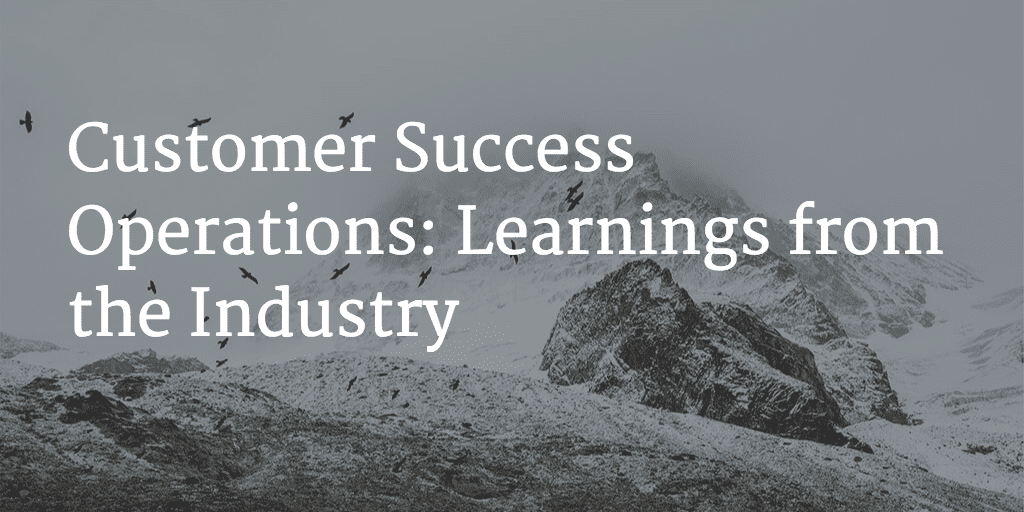As part of an ongoing discussion about the evolving role of Customer Success Operations, we are posting the takeaways from a series of discussions we’ve had with industry participants in customer success. See here for our prior posts on the topic. Additionally, if you haven’t taken our survey on CS Ops please take the CS Ops survey and enter to win an Apple Watch.
Over the past month, we at Gainsight have been spending a lot of time thinking about Customer Success Operations. We decided to reach out to some of our customers to hear your thoughts on what makes CS Ops successful. Unsurprisingly, it’s a topic that has been top of mind for you too. We’ve collected below the highlights of our conversations. A big thank you to everyone who participated in these interviews. We’re looking forward to continuing this conversation in the comments section below.
Customer success operations is born in an organization for increased scale and efficiency
For nearly all of our interviewees, the first CS Ops hire occurred at around 5 CSMs and during a period of high growth. While not having an exact job description in mind, our respondents said that they needed a new team member to free up time for CSMs and the VP of customer success. As their companies are growing, the CS organization needed someone dedicated to implementing new processes, providing the foundation to scale the CS org and allowing the CSMs to take on more accounts. All the while, not missing a step with their customers.
One respondent crystallized the moment they realized they needed their first CS Ops hire: “Early on, we were laser focused on new business so the attention was on sales. Even our first few CSMs were tasked with helping sales close deals. As we’ve matured, we’ve shifted our focus more towards renewals and achieving positive customer outcomes. Having to do so in a scalable and effective way led to our first CS Ops hire.”
The consensus view for responsibilities under CS Ops fall into three main categories
1. Customer Success Enablement
Our respondents identified that the primary responsibility for CS Ops is to enable the CSMs to do their job better and more efficiently. Responsibilities ranged from tactically setting up processes for them to interact with cross-functional teams to implementing on boarding plans to efficiently bring new CSMs up to speed. “Tooling” or advocating for the right technology for the team to deliver a high quality customer experience was also mentioned as a critical component of the role.
Before the first CS Ops hire, these responsibilities would fall broadly on the team and for someone to take the initiative. One CS Ops Manager said, “As a CSM in my former life, I was doing pricing and quoting myself, for each of my new customers for each renewal. This was a big time drag on me and my fellow CSMs. When I formally switched to CS Ops, I had the prerogative to get this process simplified and streamlined across CSMs.”
2. Strategy
For all of our interviewees, CS Ops represented an important strategic position within the organization. The first CS Ops hire was tasked with doing the primary strategic thinking on identifying customer segments, optimal engagement models and mapping out the customer lifecycle journey. For instance, one interviewee mentioned that they are responsible for determining how to leverage one-to-many communication techniques for certain customer segments. Other top mentions in the realm of strategy included identifying root causes for churn and proposing mitigating solutions and optimizing team structures and compensation metrics. One interviewee phrased this component of her role as being the “chief of staff” for her VP of CS.
3. Reporting and metrics
Reporting for many personas throughout the organization was mentioned by all of our interviewees as a critical role for CS Ops at their companies. Report categories included CEO and board decks that show customer health across the portfolio of customers, managerial reports to show allocation of accounts and time spent across CSMs, and individual CSM views to get the right information to allow for the right customer touch point at the right time.
Again, from one of our interviewees: “Data enables the business and there is significant efficiencies gained here. We try to make the business function smarter, with better decisions made throughout the organization. Getting this data in a digestible and actionable way to people throughout the company is one of the major ways I make an impact here.”
The typical background of a new CS Ops hire ranges from analytical to customer facing roles
From our interviews, we learned that CS Ops talent can come from a range of backgrounds. Some of our respondents said that sourced their first CS Ops hire from a former sales ops employee. Given their analytical background, these new hires were asked to take on analytics and reporting as a primary responsibility. Other interviewees said they hired a former CSM or shifted a CSM team member into the CS Ops role. Interviewees found this ideal as the new hires already had intimate knowledge of the CSM role and the biggest pain points. Finally, there was a significant group of interviewees who said that their CS Ops hires came from other roles, ranging from sales to straight out of college. Typical new hires had less than 5 years of work experience.
From one of our interviewees: “We went with a person with sales ops experience because we wanted someone analytical and who could do ops. Someone who could make sense of customer data and think through how to implement new processes. The initial responsibility was owning the administration of Gainsight, but that has since quickly expanded to customer segmentation, engagement models, and more.”
Sample output from our on-going survey (see survey link here, and for a chance to win an Apple watch!)
The biggest challenges CS Ops is facing today are in change management and benchmarking success for their industry
When asked what the single most challenging aspect of their job was, CS Ops interviewees sighted change management most often. One interviewee said, “Our CSMs often see the benefits of the new processes. What we struggle a lot with is getting other teams, our cross functional teams, engineering, marketing, on board with our plan. Influencing without authority has been a real learning for me.”
Another CS Ops interviewee said, “The biggest thing coming in as a new guy is managing with ambiguous authority. I really don’t want to have to cc my VP or anyone else really. It’s not effective leadership by doing that.”
Many interviewees also mentioned the lack of industry benchmarks for CS Ops. What represents “good retention”or “good up-sell”? How many accounts should we have per CSM? ARR per CSM? How many CS Ops personnel per CSM? What responsibilities typically fall within CS Ops? What about compensation for CS Ops? How does the typical CS Ops new hire advance in their career?
All of our interviewees appreciated the time to connect on CS Ops
A final observation: we heard that this is a very relevant topic for the industry, that there are many questions still left to be answered and that the path forward for CS Ops is still being figured out. As a result, we will be hosting the first Customer Success Operations summit in November. We hope to share in depth the findings from our research and have our guests collaborate to build the path forward.
Also – please stay tuned for the release of our survey results. For a chance to take the survey (and win an Apple watch!), please follow the link here.


